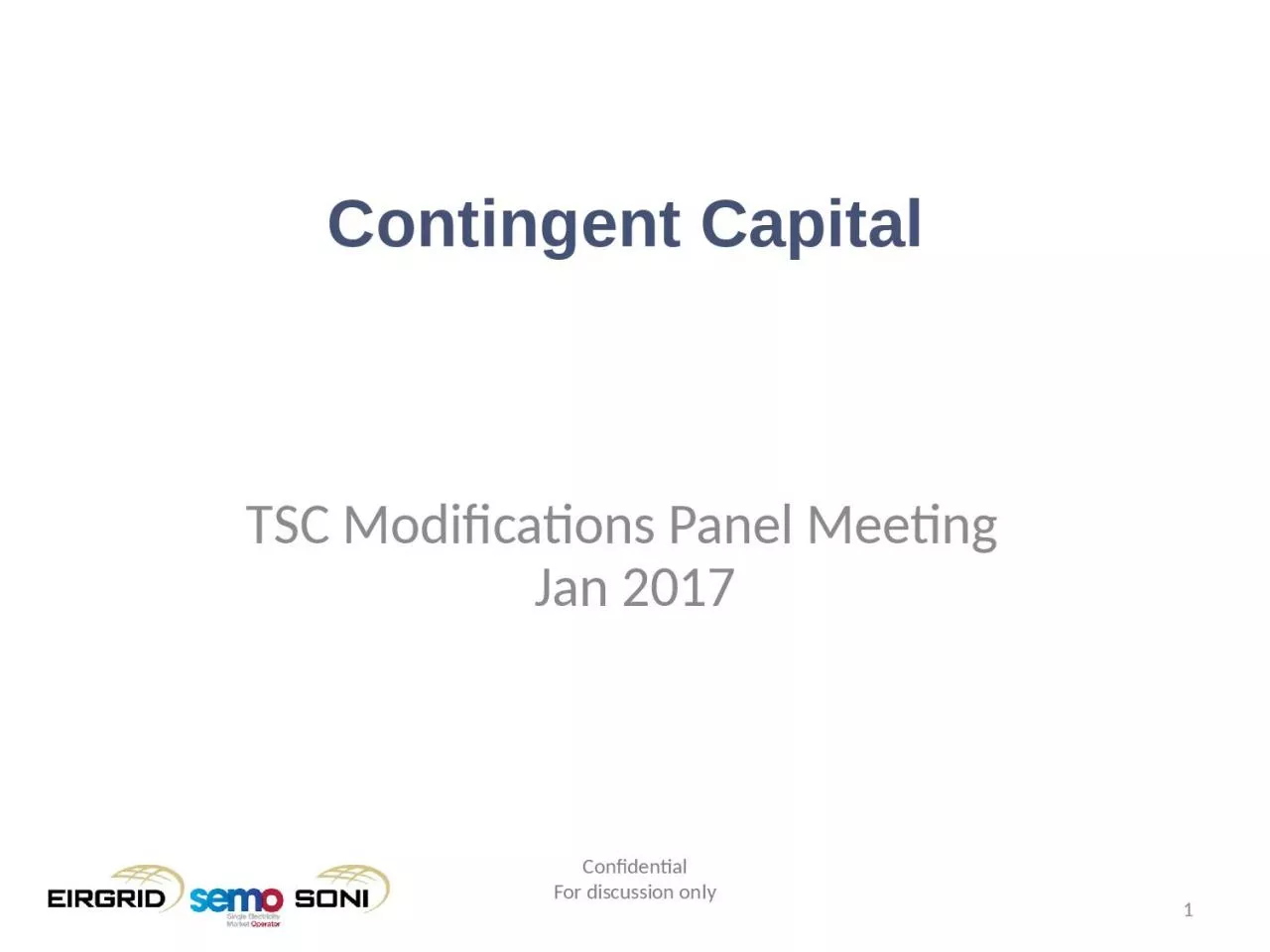

Jan 2017 Contingent Capital 1 Confidential For discussion only 2 Key Objectives Option 1 Option 2 Option 3 Review of questions from December meeting Proposed changes Vote Confidential ID: 1027446
Download Presentation The PPT/PDF document "TSC Modifications Panel Meeting" is the property of its rightful owner. Permission is granted to download and print the materials on this web site for personal, non-commercial use only, and to display it on your personal computer provided you do not modify the materials and that you retain all copyright notices contained in the materials. By downloading content from our website, you accept the terms of this agreement.
1. TSC Modifications Panel Meeting Jan 2017Contingent Capital 1ConfidentialFor discussion only
2. 2Key Objectives Option 1Option 2Option 3Review of questions from December meetingProposed changesVoteConfidentialFor discussion only
3. 3Why is contingent capital needed?Market ChargesMarket PaymentsAccumulated Charges-PaymentContingent Capital
4. 4Purpose of modificationConfidentialFor discussion onlyRecognise that contingent capital will be required for smooth running of the marketPlace obligation on Market Operator to seek credit facilityClarify sources of funding for such an arrangement (level of funding to be determined as part of normal revenue control process)RA approval required to change amount of contingent capitalPublication of any changes to all participantsFunds AvailableSurplus of Charges over Payments for the billing periodSurplus of Charges over Payments as accrued from previous billing periodsContingent Capital remainingDefine the Charges and Payments to which the Contingent Capital can apply Remedial measures if Contingent Capital is likely to be exhaustedRight to suspend and accrue payments if Contingent Capital is exhausted
5. F.21.1.3 The Market Operator shall determine the Socialisation Balance (CBSOCd) for a Settlement Day, d, through applying any adjustments necessary to the Initial Socialisation Balance calculated in accordance with paragraph F.21.1.1, including: (a) adding the amount of any Termination Charge recovered under section J.7.1 of the Capacity Market Code (and, in the event of a failure by a Participant to pay a Termination Charge invoiced under that section, any amount recovered by the System Operators as a result of a call or demand on the Participant’s Performance Security under that section) and paid to the Market Operator; and (b) to the extent the Market Operator considers appropriate, adding any accumulated over-recovery by the Market Operator in respect of another charge under this Code that is calculated by reference to a parameter or price set by the Regulatory Authorities on the basis of expected costs. 5 Socialisation fund?
6. Extent to which contingent capital is already drawne.g. if DBC running above or below budgetAbility to fill the hole in the hedgeScarcity event – price exposure is 2,500€/MWh500€/MWhr strike price3,000 €/MWhr scarcity price400 MW unit un-available for 8 hours = 8m€6Factors to be considered
7. Imperfections chargeContingent Capital RequirementReduce paymentsMarket rules, bidding code of practiceSuspend and accrueonly after Contingent Capital is exhausted 7Running Order – prescriptive?
8. DBC is the main driver of contingent capital draw downTSO’s monitor DBC continuouslyStanding agenda item for fortnightly meeting with RA’sCan include trend alert Decision required to send out Market MessageHigh frequency public reportsIllustrate impact of individual participant's bidding behaviour Short term fluctuations may be misleadingEarly warning to the RA’s may trigger notification to industry8Transparency
9. Difficult to forecast – wide error barsTariff setting on the worst case scenario?Tariff’s are subject to regulatory approvalContingent capital ~ insuranceInsurance has a cap9Forecasting Accuracy
10. 10End
11. 11Change in key assumptions – SEM v I-SEMCategoryChange in I-SEMImpactCapacityCapacity auction process in I-SEM compared to a “pot” set at the beginning of a year in SEMCapacity is self funded (pass through) on a monthly basis in SEM compared to a Tariff mechanism in I-SEM Monthly payments ≠ receipts in I-SEMSeasonal impact in Year 1 as Go Live is May-18 which is coming into the trough summer months. Payments made on a straight line basis but receipts recovered on a demand profile basis. Likely to result in a cumulative deficit build up during the summer months which should unwind during the winter months. This is a Year 1 funding risk only as the tariff year normally starts in Oct which is coming into peak winter months. Constraints & Residual Error (REVLF)Change in market rulesNot required to bid on SRMC basis Participant will be paid the higher of bid price or market price for ConstraintsREVLF moving from pass through to tariff mechanism in I-SEM Market Interconnector Ramp rate ≠ Physical Expected increase in volatility in imbalance price due to change in bidding rulesMarket riskIntrinsic risk associated with the introduction of a new market Extremely difficult to quantify. Risks include:Market behaviourDesign risk Remedy periodConfidentialFor discussion only
12. 12Estimate of how much is needed